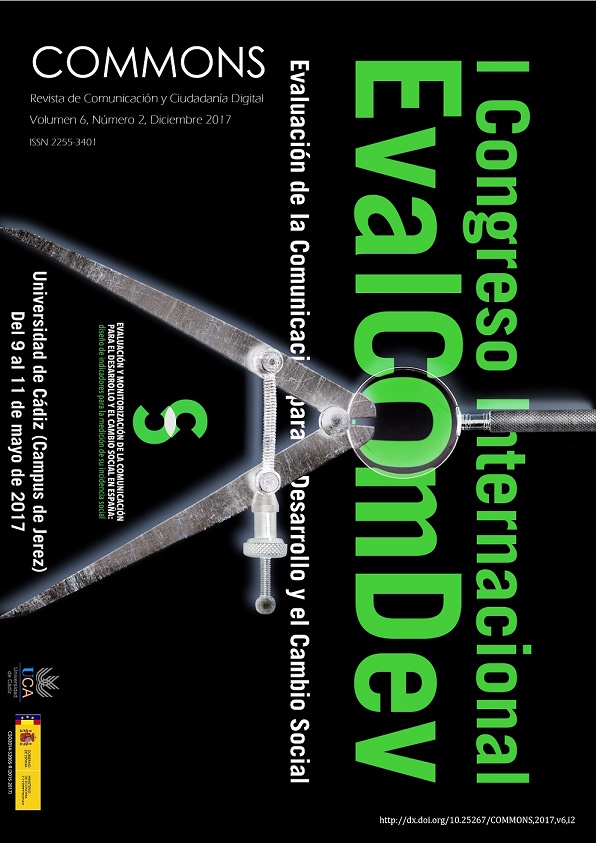Estar juntos en red: activismo e intimidad en las redes sociales / Joined Together in the Net: Activism and Intimacy in Social Networks

Additional Files
Info
Abstract
This paper tries to analyse how social networks of some communities of activists work, specifically the personal interaction between members and the possible audience. The creation of complicities through interaction belongs to the concept of intimacy according to philosopher José Luis Pardo, who insists in the definitely communicative nature of this phenomenon. We can confirm the wasted of potentially for mobilization and emotional energy that interaction can give.
Keywords
Downloads
How to Cite
License
Authors who have published with this journal accept the following terms:
- Authors shall retain their copyright and guarantee the journal the right of first publication of their work, which shall simultaneously be subject to the Creative Commons 3.0 Recognition License, which allows third parties to share the work as long as its author and first publication are indicated in this journal.
- Authors may adopt other non-exclusive licensing agreements for the distribution of the published version of the work (e.g., depositing it in an institutional telematic archive or publishing it in a monographic volume) provided that the initial publication in this journal is indicated.
- Authors are permitted and encouraged to disseminate their work via the Internet (e.g., in institutional telematic archives or on their website) before and during the submission process, which may lead to interesting exchanges and increased citations of the published work. (See The Effect of Open Access).
References
ALONSO GONZÁLEZ, Marián (2015): Nuevas tecnologías y cambio social: Los yayoflautas se organizan en la red para generar Transformaciones sociales. Commons. Revista de Comunicación y Ciudadanía Digital. Volumen 4, Número 1, pp. 6-37. Recuperado de http://bit.ly/2vJBTu2
CASTRO NOGUEIRA, Luis; CASTRO NOGUEIRA, Miguel Ángel & MORALES NAVARRO, Julián (2013). Ciencias sociales y naturaleza humana. Una invitación a «otra» sociología y sus aplicaciones prácticas. Madrid: Tecnos.
CASTRO NOGUEIRA, Laureano; CASTRO NOGUEIRA, Luis & CASTRO NOGUEIRA, Miguel Ángel (2008). ¿Quién teme a la naturaleza humana? Madrid: Tecnos.
COLLINS, Randall (2009). Cadenas de rituales de interaccion. Barcelona: Anthropos.
DERRIDA, Jacques (1995). Archive Fever: A Freudian Impression. Diacritics. Vol. 25, No. 2 (Summer, 1995), pp. 9-63. Recuperado http://bit.ly/2iLtaFH
GALLEGO DUEÑAS, Francisco Javier (2012) Gramáticas del secreto (Sociolingüística y secreto). Tonos digital: Revista electrónica de estudios filológicos, Nº. 25. Disponible en http://bit.ly/2vvAYRV
GRICE, H.P. (1991). Lógica y conversación. En VALDÉS VILLANUEVA, L. La búsqueda del significado. Madrid: Tecnos.
GUMUCIO-DAGRON, Alfonso (2011): Comunicación para el cambio social: clave del desarrollo participativo. Signo y Pensamiento, vol. XXX, núm. 58, enero-junio, 2011, pp. 26-39. Recuperado http://bit.ly/1x8um66
HARAWAY, Donna (1991, 1995). Ciencia, Cyborgs y mujeres. Madrid: Cátedra.
IRANZO, Amador & FARNÉ, Alessandra (2014): Herramientas de comunicación para el tercer sector: el uso de las redes sociales por las ONGD catalanas. Commons. Revista de Comunicación y Ciudadanía Digital. Volumen 3, Número 2. Recuperado http://bit.ly/2esRevU
LASÉN, Amparo (2014). Remediaciones, móviles de subjetividades y sujeciones en relaciones de pareja. En LASÉN, Amparo & CASADO, Elena (eds). Mediaciones Tecnológicas. Cuerpos, afectos y subjetividades. (pp. 19-37). Madrid: Universidad Complutense. CIS.
LATOUR, Bruno (2008). Reensamblar lo social. Una introducción a la Teoría del Actor Red. Buenos Aires: Manantial.
MAFFESOLI, Michel (1990). El tiempo de las tribus. Madrid: Icaria.
MARÍ Sáez, Víctor (2005). El deseo de enredarse y el peligro de liarse. Un autodiagnóstico sobre los procesos de apropiación de internet por parte de los movimientos sociales y la ciudadanía activa. Revista Textos de la Cibersociedad, 9. Temática Variada. Recuperado de http://bit.ly/2cqlgM1
MARÍ SÁEZ, Víctor (2007). Contra la evaporación de la dimensión política d ella comunicación. Movimientos sociales, ONG y usos de Internet. Zer, 22, p. 453-471. Recuperado de http://www.ehu.eus/zer/hemeroteca/pdfs/zer22-23-mari.pdf
MARÍ SÁEZ, Víctor (2013). Comunicación, desarrollo y cambio social en España: entre la institucionalizaicón y la implosión del campo. Commons. Revista de Comunicación y Ciudadanía Digital. Vol 2. N.º 3. Recuperado de http://bit.ly/2grqrka
PARDO, José Luis (2004, 1996). La intimidad. Valencia: Pre-Textos.
SÁNCHEZ SERRADILLA, Alba (2016): Ciberactivismo y ciberactividad en los medios de comunicación comunitarios. Commons. Revista de Comunicación y Ciudadanía Digital. Volumen 5, Número 1 pp. 38-64. Recuperado de http://bit.ly/2iL6Dsz
SIMMEL, Georges. (1908, 1986). Del secreto y la sociedad secreta. En Sociología. Vol 1. 357-424. Madrid: Alianza
SLOTERDIJK, Peter (2003, 1998). Esferas I. Burbujas. Madrid: Siruela.
TURKLE, Sherry (2011): Alone Together. Why We Expect More From Technology and Less from Each Other. New York: Basic Books
WATTS, Duncan J. (2006, 2003). Seis grados de separación. La ciencia de las redes en la era del acceso. Barcelona: Paidós.
WILSON, Deindre & SPERBER, Dan (2004). La teoría de la relevancia. Revista de investigación Lingüística. Vol VII: 233-282. Recuperado de http://bit.ly/2vJ5P9R
ZAFRA, Remedios (2012). Vínculos que importan. Apuntes sobre la identidad política en la era de las redes. Teknokultura. Revista de cultura Digital y Movimientos Sociales (2012), Vol. 9. Núm 1: 105-11. Recuperado de http://bit.ly/2esQk2s


